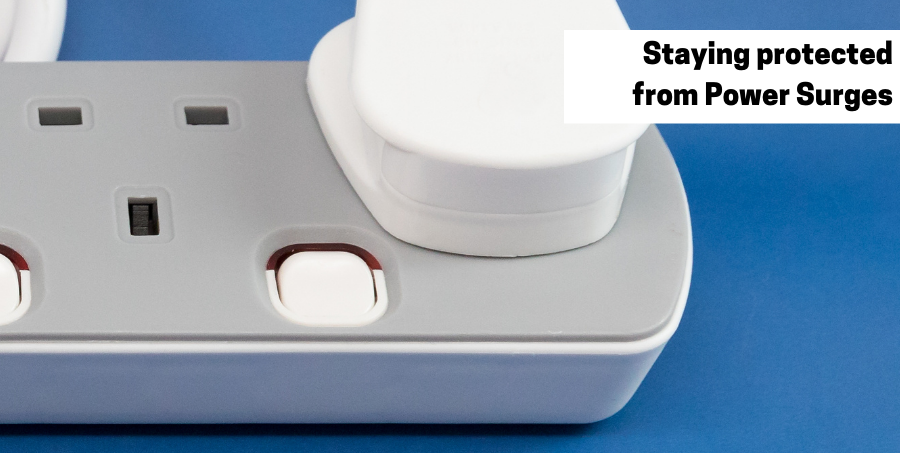Is it time to buy a new surge protector?

While it’s true that electricity and water are two entities that shouldn’t be mixed, they behave in similar ways in one important respect. Both follow the path of least resistance, flowing from high-pressure areas to lower-pressure areas.
Of course, the pressure in an electrical wire differs from that in a water pipe in that its pressure is measured in volts, not ‘bars’ like water pressure. However, the principle is the same: it flows along a conducting wire from the high electrical potential energy end (the higher voltage) to the lower potential electrical energy end (the lower voltage).
Power surges
Every so often, however, the mains voltage driving the current through your cables to your appliances doesn’t behave constantly. It can ‘spike’ or surge suddenly, driving a much higher current through the wire and posing a serious risk of electrical damage to appliances on the receiving end – not much fun if your expensive fridge-freezer or high-end computer or games console gets its insides fried.
This is where surge protectors (sometimes called surge suppressors) come into play. Their job is straightforward, and they can spare you some very unwelcome expenses by protecting your precious electrical equipment. When there’s an electrical surge, a surge protector detects the excess voltage and diverts the surplus safely into its earth or grounding pin (that third prong on a standard UK plug).
What causes power surges?
Many people think that lightning is the commonest cause of electrical power surges in domestic properties. While it’s true that lightning can indeed cause huge power spikes, it really isn’t the most widespread cause of them. Much more typically, they come from other electrical appliances in the home – specifically, the ones requiring the most electrical power to operate properly, such as air-conditioning units, freezers, and electrical hobs and ovens.
You might have ‘seen’ a power surge without understanding what it was: lights will sometimes flicker when they strike. High-consumption appliances drag in a lot of power, and, for example, on a hot day when lots of people are flipping on their air conditioners at the same time, the combined effect will put a strain on the smooth operation of the grid, resulting in power spikes.
When to use a surge protector
As surges can and do happen at any time, it’s best to keep surge protectors in situ all the time. Not everything needs one, of course (you won’t need one for a desk lamp, for example). However, with anything that has intricate and delicate microprocessors inside, such as your beloved high-end laptop, your fabulous HD TV, your stereo or media centre, don’t take the risk. Plug them into a surge protector rather than directly into the wall socket. Rule of thumb: if it’s electrical and expensive, protect it with a surge protector.
Bear in mind that an electrical surge won’t necessarily instantly destroy your electrical equipment. More typically, multiple small surges over time cause cumulative damage. Routing several of your devices into a single multi-gang surge protector can therefore kill, or rather protect, several birds with one stone.
What to look for in a surge protector
Here are the basics:
- UL rating – All good surge protectors bear a ‘UL Rating’, which is issued by the independent Underwriters Laboratories (hence the moniker). These test the safety of electrical devices. If the protector you’re looking at doesn’t have a UL rating, leave it on the shelf and find one that does.
- Indicator lights – These are a particularly helpful safety feature as they can tell you at a glance if your surge protector is still working or whether you need to replace it. Basically, if the light is off, send off for a new protector.
- Joule rating – This refers to the upper level of electrical energy that the surge protector can safely absorb. If the surge exceeds this, the protector becomes useless, so the higher the rating, the better. 1000 joules is good, but 2000 joules is much better.
- Clamping voltage – This is basically the voltage at which the surge protector starts to divert surplus electricity away from the plugged-in devices. The lower the clamping voltage, the earlier its protective diversion mechanism will kick in. Anything below 400 volts is considered safe for domestic usage.
- Response time – This is the time it takes for the protector to sense a surge in power. The lower the response time, the faster the safety mechanism kicks in, thereby exposing plugged-in devices to shorter periods of excess power. The lower the value, the better (any protector with a response time of 1 nanometer or faster is good).
Where to get your surge protectors
EuroNetwork is one of the UK’s largest manufacturers and vendors of safe, well-produced cables and plugs. Among its many offerings are surge-protected multi-gang plugs to protect several devices at once. All are thoroughly tested on site before dispatch to ensure proper, safe functioning as soon as they arrive at your door.

